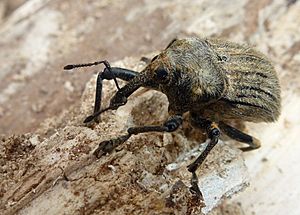Elephant weevil facts for kids
Quick facts for kids Elephant weevil |
|
|---|---|
 |
|
| Scientific classification | |
| Genus: |
Rhynchodes
|
| Species: |
ursus
|
The elephant weevil (scientific name: Rhynchodes ursus) is a fascinating insect found throughout New Zealand. This large weevil is known for boring into wood. Adult weevils like to gather on trees, where they enjoy feeding on tree sap.
The young weevils, called larvae, dig tunnels inside dead tree trunks and branches. They especially like trees such as southern beeches, rimu, and Dracophyllum traversii.
Discovering the Elephant Weevil
The elephant weevil was first described in 1846 by a zoologist named Adam White. Its scientific name, Rhynchodes ursus, helps scientists around the world know exactly which creature they are talking about.
What Does It Look Like?
This weevil is quite large and has a deep brown color. It often has two lighter bands on the sides of its thorax, which is the middle part of its body. Its legs are black, and each upper leg (called a femur) has a small patch of yellowish-brown hairs.
The weevil's body is covered in many tiny scales. These scales can sometimes look like fine hairs. If you look closely at their antennae, you'll notice a difference between males and females. In female weevils, the antennae are placed about halfway along their snout (called a rostrum). In males, the antennae are closer to the front of the snout.
Life in the Trees
Elephant weevils spend most of their lives connected to trees. The adult weevils are often seen on the outside of trees, where they find their food. They use their strong mouthparts to feed on the sap that flows from the tree.
The larvae, or young weevils, live a hidden life. They are like tiny engineers, tunneling deep inside the wood of dead or dying trees. These tunnels provide them with both food and shelter as they grow.
A Wasp's Host
The larvae of the elephant weevil play an important role in nature. They are the main host for New Zealand's largest parasitic wasp, called Certonotus fractinervis. A host is an animal that another creature lives on or in.
Female Certonotus fractinervis wasps have a very long, needle-like tool called an ovipositor. They use this ovipositor to lay their eggs right inside the weevil larvae. The wasp eggs then hatch and grow inside the weevil larvae while they are still developing within the trees. This is a natural way that populations are controlled in the wild.

